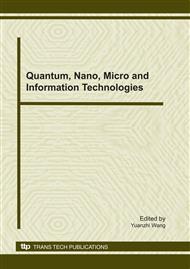[1]
H. Bay, T. Tuytelaars, and L. Van Gool. Surf: Speeded up robust features. European Conference on Computer Vision, 1: 404–417, (2006).
DOI: 10.1007/11744023_32
Google Scholar
[2]
Y. LeCun, L. Bottou, Y. Bengio, and P. Haffner, Gradient-based learning applied to document recognition, Proceedings of the IEEE, vol. 86, p.2278–2324, November (1998).
DOI: 10.1109/5.726791
Google Scholar
[3]
C. K. Liu, A. Hertzmann, and Z. Popovic, Learning physics-based motion style with nonlinear inverse optimization, ACM Trans. Graph., vol. 24, no. 3, p.1071–1081, (2005).
DOI: 10.1145/1073204.1073314
Google Scholar
[4]
O. Arikan, D. A. Forsyth, and J. F. O'Brien, Motion synthesis from annotations, in Proc. SIGGRAPH, (2002).
Google Scholar
[5]
M. Brand and A. Hertzmann, Style machines., in Proc. SIGGRAPH, p.183–192, (2000).
Google Scholar
[6]
R. Urtasun, P. Glardon, R. Boulic, D. Thalmann, and P. Fua, Style-based Motion Synthesis, Computer Graphics Forum, vol. 23, no. 4, p.1–14, (2004).
DOI: 10.1111/j.1467-8659.2004.00809.x
Google Scholar
[7]
Pavlovic V,Rehg J M ,Chain T J,el al, A dynamic Bayesian network approach to figure tracking using learned dynamic models, Proceedings of the 7th Internalional Conference on Conaputer Vision,Corfu, 1999.94~101.
DOI: 10.1109/iccv.1999.791203
Google Scholar
[8]
Howe N R, Leventon M E,Freeman W T. Bayesian reconstruction of 3D hunmn motion from single camera video, Advances in Neural lnfornmtion Processing Systems, Cambridge, Massachusetts: MIT Press, 2000,12:820~826.
Google Scholar
[9]
Sidenbtadh H,Black M J, Fleet D J.Stochastic tracking of 3D human figures using 2D image motion, Proceedings of the 6th European Conference on Computer Vision, Dublin, 2000, 702~7I8.
DOI: 10.1007/3-540-45053-x_45
Google Scholar
[10]
Zhao T, Wang T S, Shum H Y. Learning a highly struetured motion for 3D human tracking, Proceedings of the 5th Asian Conference on Computer Vision, Melbourne,2002, 144~149.
Google Scholar
[11]
Chain T J,Rehg J M.A multiple hypothesis approach to figure tracking, Proceedings of the IEEE Conference on Computer Vision and Pattern Recognition, Fort Collins, Colorado, I999, 239~245.
Google Scholar
[12]
Ramanan, D., Forsyth, D. A., and Zisserman, A. Strike a Pose: Tracking People by Finding Stylized Poses., Computer Vision and Pattern Recognition (CVPR), San Diego, CA, June (2005).
DOI: 10.1109/cvpr.2005.335
Google Scholar


